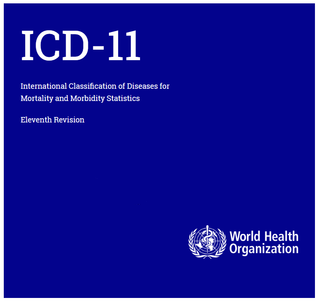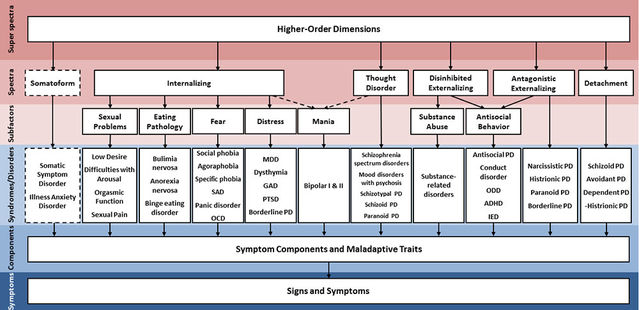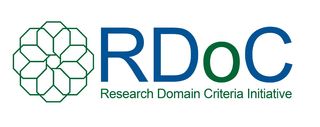DSM
Are There Viable Alternatives to the DSM-5?
Can ICD, PDM, HiTOP, RDoC, or PTMF win a kind of diagnostic game of thrones?
Posted May 22, 2019 Reviewed by Lybi Ma
Despite oft-heard complaints, the Diagnostic and Statistical Manual of Mental Disorders (DSM-5) continues to be the primary diagnostic manual used by mental health professionals. However, in the last few years there has been a lot of discussion about potential alternatives. Following is a primer on several alternatives for those interested in learning about them. Can any of these alternatives win something roughly akin to a diagnostic game of thrones? Let's review some of the main competitors.

International Classification of Diseases (ICD)
The ICD is the best known and most popular alternative to DSM-5—perhaps because it is the keeper of the diagnostic codes used for tracking incidence and prevalence rates, as well as for health insurance reimbursement. The ICD, which includes not just mental health diagnoses but all disease-related diagnoses, is published by the World Health Organization (WHO). The current edition is the ICD-10; the ICD-11 is on its way. The ICD offers a category-based approach that is similar to DSM-5; the manuals are "harmonized" to be in agreement much of the time). However, there are several areas where the ICD directly challenges DSM-5 orthodoxy (e.g., radically overhauling personality disorders, maintaining the substance abuse/dependence distinction, and shifting certain diagnoses such as gender dysphoria/incongruence out of the mental disorders section of the manual). ICD's similarity to the DSM is perhaps its biggest advantage, but may also make it less appealing to those more critical of some of the assumptions that the DSM and ICD share.
Learn more about the ICD:
- WHO's ICD-11 site
- ICD-11's Mental, Behavioral, and Neurodevelopmental Disorders
- Overview of ICD-11 Revision of Mental Disorders
- The Most Frequently Used ICD-10 Codes in Behavioral Health in 2017

Psychodynamic Diagnostic Manual (PDM)
The Psychodynamic Diagnostic Manual (PDM) recently published its second edition, the PDM-2. The PDM's major criticism of the DSM and ICD is that they fail to properly assess personality and, in their efforts to be descriptive rather than theoretical, they fail to provide clinicians the detailed information necessary to guide effective interventions. The PDM is probably next best-known after the ICD, as evidenced by the fact that it has already gone through two successful editions. Its explicitly psychodynamic take on diagnostics provides an interesting contrast to the DSM and ICD's mostly atheoretical approach. Given its expressly theoretical rooting in psychodynamic perspectives, the challenge for the PDM is whether clinicians who do not identify as psychodynamic would adopt it.
Learn more about the PDM:
Hierarchical Taxonomy of Psychopathology (HiTOP)
The Hierarchical Taxonomy of Psychopathology (HiTOP) takes a dimensional approach to diagnosis, eschewing traditional categories found in DSM and ICD because of well-known problems with the reliability and validity of those categories. Influenced by personality dimension research (like that used to arrive at the Big 5 personality traits), HiTOP holds that DSM and ICD categories often suffer from comorbidity problems (i.e., clients qualify for multiple diagnoses, calling into doubt whether the categories truly are distinct diagnostic entities). Its solution? A diagnostic system that divides psychopathology into six "spectra dimensions." By assessing along these six spectra, clinicians can ostensibly obtain a richer and more clinically useful understanding of clients. HiTOP not only sees itself on stronger scientific footing than DSM or ICD, but ultimately hopes to simplify and streamline diagnosis by moving us away from the ever-increasing number of questionable DSM and ICD diagnostic categories. Like most of the other approaches discussed, HiTOP still locates pathology within the individual, but does so in a radically different way by replacing a reliance on mutually-exclusive diagnostic categories with more fluid and interrelated personality dimensions.

Learn more about HiTOP:

Research Domain Criteria (RDoC)
The Research Domain Criteria (RDoC) initiative is sponsored by the National Institute of Mental Health (NIMH). It received a lot of attention a few years ago when NIMH announced that it would no longer fund research proposals that use DSM diagnoses, instead requiring researchers to use the RDoC matrix. This led some to mistakenly believe that RDoC is a ready-for-prime-time alternative to the DSM. However, it remains a research initiative attempting to build a diagnostic system from the ground up—one that uses biological markers to diagnose mental disorders. Its research is not yet far enough along for RDoC's adherents to construct a strictly biomarker-based diagnostic scheme. RDoC hopes one day to replace the DSM with a thoroughly biomarker-based alternative system, but encourages clinicians to keep using the DSM in the meantime. Only time will tell whether RDoC's strongly medical model approach will succeed.
Learn more about RDoC:
- Research Domain Criteria (RDoC) (NIMH site)
- The Promise of the Research Domain Criteria (RDoC) Initiative
-
Toward the Future of Psychiatric Diagnosis: The Seven Pillars of RDoC

Power Threat Meaning Framework (PTMF)
Although the Power Threat Meaning Framework (PTMF) is an alternative to the DSM, it doesn't consider itself a "diagnostic" system. In fact, it rejects the notion of "psychiatric diagnosis" altogether, arguing that the mental health professions improperly attribute mental distress to "pathology" located within individuals rather than seeing it as a byproduct of socially oppressive circumstances. Thus, the PTMF assesses the ways in which socially oppressive power structures lead to psychological threat that results in people constructing particular meanings about what has happened to them. Mental distress, therefore, is reframed as a response to social adversity (e.g., oppression, discrimination, poverty). PTMF is noteworthy because it marks an attempt to develop an alternative to the medical model that forms the foundation of most other diagnostic approaches. Instead of seeing individuals as afflicted with disorders that reside inside them, PTMF sees mental distress as a reasonable and expected (if not always effective) response to unbearable social circumstances. As such, it is the most rebellious of the alternatives outlined.
Learn more about the PTMF:
-
The Power Threat Meaning Framework (full document outlining the approach)
-
Challenging Narratives: What is The Power Threat Meaning Framework?
To learn more about potential diagnostic alternatives to the DSM-5, check out this podcast I did with Jessica Janze at Mad In America Radio. We discussed many of the above alternatives; you can listen by clicking the play button on the podcast player below. For those who prefer to read a transcript of the podcast, click here.
LinkedIn Image Credit: Phat1978/Shutterstock


